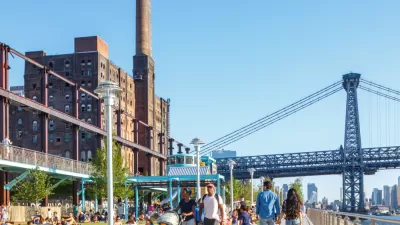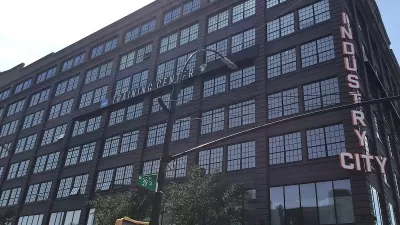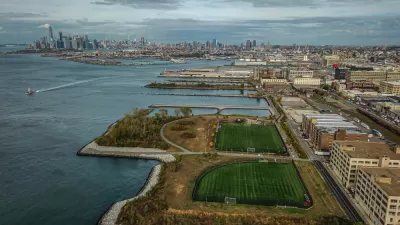A new feature on the Brooklyn waterfront is a reminder that Domino Sugar has made several unsavory appearances in the history of Puerto Rican communities.
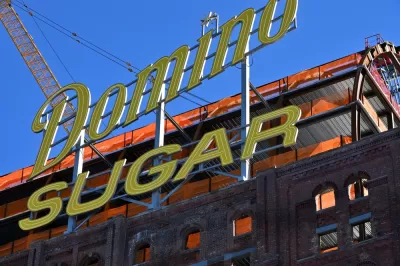
Seen from Manhattan, the Brooklyn waterfront has been changing dramatically for the past two decades as the result of increasing real estate development and gentrification. One recent change was more conspicuous than others: an illuminated replica of the old Domino Sugar sign was hoisted to where it hung for nearly a century, looming over the Williamsburg Bridge at the site of the former Domino Sugar Refinery.
At night, the sign dazzles drivers and subway riders heading over the bridge, throwing a glow onto the East River. It crowns a luxurious new building called The Refinery at Domino. After purchasing the shuttered sugar refinery in 2012, real estate development firm Two Trees spared no expense to convert the deindustrialized husk into an opulent office building.
Rezoning and construction at Domino has taken nearly two decades. It has transformed an asset of Brooklyn’s old working class into an asset of Brooklyn’s new gentry, becoming a symbol of Brooklyn’s transformation in the process. During that transformation, many residents in the adjacent Southside Williamsburg neighborhood—a stronghold for Puerto Rican people and culture—have been pushed out. The existing residents have continued to fight to preserve their cultural heritage as the area has become more affluent.
Ironically, as the Domino Sugar property has contributed to the partial erosion of Puerto Rican culture in South Williamsburg, Domino Sugar helped dramatically erode Puerto Rican autonomy in Puerto Rico itself more than 100 years ago.
In the early 1900s, about 60 percent of the sugar consumed in America passed through the Domino Sugar Refinery. Much of it arrived in the Brooklyn Navy Yard on boats from Puerto Rico, where the commodity was squeezed from the island like sucrose from crushed cane stalks.
The United States took possession of Puerto Rico from Spain in 1898 after the so-called Spanish American War. Charles Herbert Allen became the first civilian governor of the island in 1900 and shortly thereafter produced the First Report of the Governor of Porto Rico. More than any other concerns, this report dealt with agriculture, and sugar in particular. It noted that entrepreneurs could produce sugar on the island for $10 less per-ton than Java, $12 less per-ton less than Cuba, and $47 less per-ton than Louisiana and Texas.
Allen left his post after just 17 months to become the treasurer and then president of American Sugar Refining, which was renamed Domino Sugar shortly thereafter. Then, he brought the company into Puerto Rico. Wielding the power of the U.S. government in the form of land grants, subsidies, water rights, railroad easements, and tax advantages, Allen built the largest sugar operation in the world. “In effect,” writes former New York State Assemblymember Nelson Antonio Denis, “Allen leveraged his governorship into a controlling interest in the entire island economy.”
In 1922, the U.S. Supreme Court ruled Puerto Rico was a territory. As a result, the U.S. Constitution and the minimum wage and collective bargaining rights it guaranteed to citizens did not apply there, helping to preserve high profit margins for sugar production on the island. By 1930, 45 percent of all arable land in Puerto Rico was sugar plantations. By 1934, every sugar plantation was owned by one of forty-one syndicates, 80 percent of which were U.S.-owned, according to Denis in his book War Against All Puerto Ricans: Revolution and Terror in America’s Colony. Puerto Rico became a single-crop economy. People could no longer farm coffee, tobacco, or even subsistence crops. As a result, even today the fertile isle must import 85 percent of its food.
Meanwhile, Brooklyn’s Domino Sugar Refinery became the largest in the Americas. It anchored South Williamsburg and provided jobs for thousands of working class New Yorkers, including many Puerto Ricans. In the 1920s, when the U.S. was restricting access to many immigrants, Puerto Ricans were granted “preferential” status. There were few job opportunities on the island beyond the cane fields and mills, and many Puerto Ricans flocked to the States. In Brooklyn, they settled around the Navy Yard and soon spread out into the surrounding areas, including Southside Williamsburg. They lived and worked in the shadow of the Domino Sugar Refinery in “Los Sures,” as they would later call the area.
The factory shut down in the mid-2000s after it was purchased by the Community Preservation Corporation (CPC), who intended to demolish the factory and build a new mixed-use development in its place. “When the Domino Sugar Factory closed, I was working at Teddy’s Bar and Grill in Williamsburg, which back then was a totally different community, with a lot of immigrant and blue-collar families,” said Megan Sperry, the documentary filmmaker behind “The Domino Effect.” “Those folks came into the bar afterward, and they were at a loss.”
CPC’s proposal was deeply unpopular with the local community and was never carried out. In 2012, CPC went bankrupt and Two Trees bought the property. Their plan included a public park and more housing units that were affordable for people earning the area median income. It was less unpopular with the local community, favored by many civic types, and unanimously approved by the City Planning Commission in 2014.
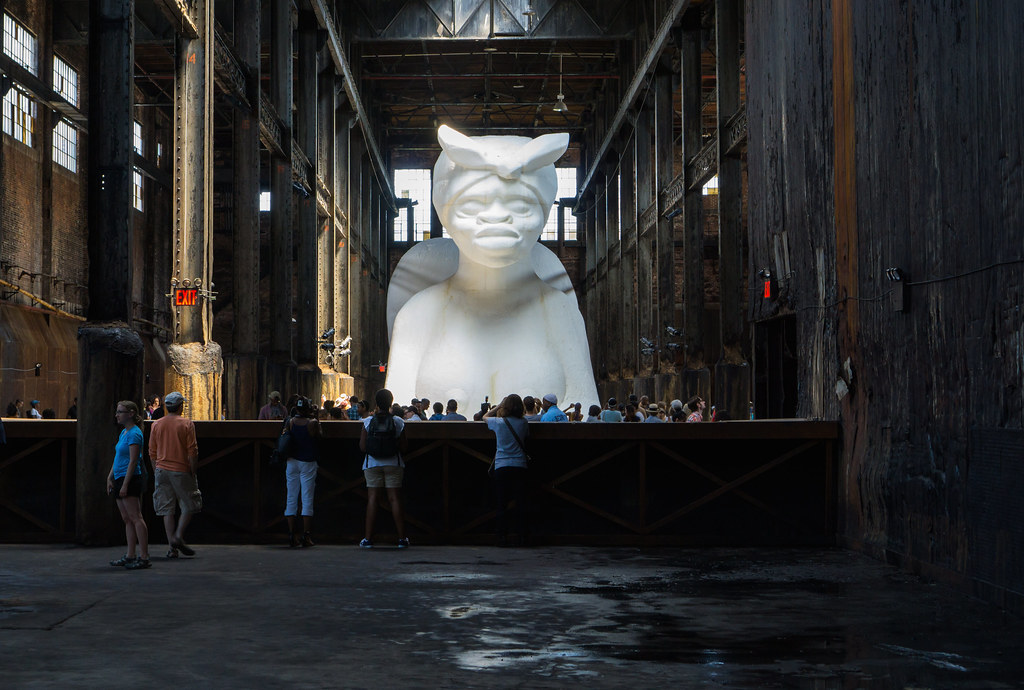
Days before City Planning approved the rezoning, an exhibition by artist Kara Walker and underwritten by Two Trees opened within the empty refinery building. A Subtlety featured an enormous, white sphinx-like figure with African features dominating the cavernous space. Smaller "attendant" figures which looked like blackamoors were scattered around it. The former appeared to be built of sugar and the latter of molasses. “Subtleties” were sugar sculptures made for the rich as edible table-decorations, and the exhibition was obviously commenting on the sugar trade, built on slavery and forced labor and helmed by companies like Domino.
Today, many are hailing the Domino Sugar sign’s return and breathlessly describing the building as an architectural marvel. “Brooklyn’s historic Domino Sugar Factory restoration lights up with signs of progress,” boasts one headline. The sign can symbolize progress depending on your definition of that word, but it may symbolize something else to Boricuas from Los Sures.
Whether in Southside Williamsburg or San Juan, Domino Sugar continues to make conspicuous appearances in the history of Puerto Rican communities.

Montreal Mall to Become 6,000 Housing Units
Place Versailles will be transformed into a mixed-use complex over the next 25 years.

Planetizen Federal Action Tracker
A weekly monitor of how Trump’s orders and actions are impacting planners and planning in America.

DARTSpace Platform Streamlines Dallas TOD Application Process
The Dallas transit agency hopes a shorter permitting timeline will boost transit-oriented development around rail stations.

Study: 4% of Truckers Lack a Valid Commercial License
Over 56% of inspected trucks had other violations.

Chicago Judge Orders Thousands of Accessible Ped Signals
Only 3% of the city's crossing signals are currently accessible to blind pedestrians.

Philadelphia Swaps Car Lanes for Bikeways in Unanimous Vote
The project will transform one of the handful of streets responsible for 80% of the city’s major crashes.
Urban Design for Planners 1: Software Tools
This six-course series explores essential urban design concepts using open source software and equips planners with the tools they need to participate fully in the urban design process.
Planning for Universal Design
Learn the tools for implementing Universal Design in planning regulations.
City of Mt Shasta
City of Camden Redevelopment Agency
City of Astoria
Transportation Research & Education Center (TREC) at Portland State University
US High Speed Rail Association
City of Camden Redevelopment Agency
Municipality of Princeton (NJ)



























